What images does the word Denver evoke? Blue skies? Temperature swings? Snow that melts the next day? Drought? High altitude (it’s not called the Mile High City for nothing)? It’s all of this and more.
The Denver Botanic Gardens are a fount of knowledge and example for those live in the Denver area and a place of beauty as well. The Garden is huge. There are seventeen Gardens of the West that feature plants that thrive in Colorado’s climate and provide long seasons of color and texture. I also want to mention the gardens inspired by plants from Japan, China, South Africa, and the tropics that feature plants from other steppe regions that have similar climates and soils.

There are many forms, textures, and colors in this section of the Water Smart Garden.
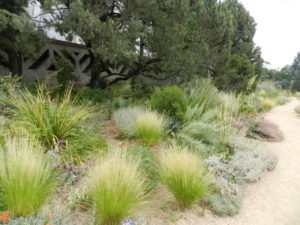
The greens and grays are an unusual color combination. The number of grays is an indication that this is a xeriscape.
I was quite impressed with the Water Smart Garden. There are two ways to experience this long garden that sits between the main sidewalk and the Orangery. One is to view it from the sidewalk but the other is to take the winding path through it. I recommend doing both. This garden demonstrates that xeriscapes do not need to lack texture or color but can be just as beautiful as traditional gardens. I do admit to Stipa (Nasella) tenuissima envy. This grass is so graceful and I love the white inflorescence.

There are a wide variety of shapes and textures as well as color in the Steppe Garden.
The Steppe Garden is not huge but it amply provides a plethora of plants from other countries that are just as useful in Colorado gardens as they are in their own.
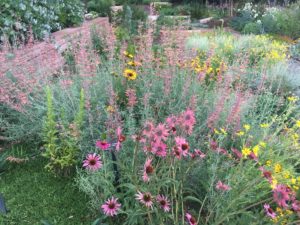
I’m a big fan of xeriscapes and nothing exemplifies that type of planting more than Agastache rupestris, Echinacea tenneseensis, and Englemannia peristenia (Engelman’s Daisy).
I don’t remember where in the garden I saw this lovely combination but it is as drought tolerant as can be.
For those who visit, seeking beauty and serenity, there are ornamental gardens that please the senses, particularly those of smell and sight, at different times of year. The sun is so strong in Denver that one often seeks shade and the Garden has shady gardens that provide diverse plant palettes offering pleasing plant combinations for a variety of moisture conditions while also furnishing habitat for birds and insects.
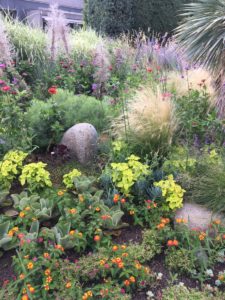
The plant palette of this corner of the Promenade Garden is Lantana, Nasella, and
Agastache but the design says that it is an English border.
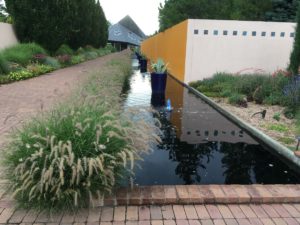
The looseness of this Fountain Grass is the perfect counterpoint to the linearity of the pool and the wall.
Not far from the entrance of the main garden, on the left is the Promenade Garden, a long, beautifully designed “English” border. What makes it a Colorado garden is the plant palette. Perpendicular to the Promenade Garden is a long pool that runs the length of a golden yellow wall. Bordering the pool is a mass of Pennisetum orientale ‘Karley Rose’ that echoes the color of the rose-colored pavers..
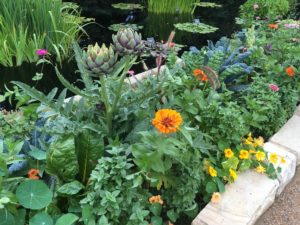
One of the Potager borders consists of artichoke, Calendula, Nasturtium, kale ‘Lacinato’, and zinnias, a feast for the eyes and the mouth.
Colorado may be relatively dry in most areas but its residents are just as enchanted with growing food as the rest of the country. Surrounding a lily pond, the extensive Potager offers many examples of designed beds and interesting edibles that could be incorporated into a home garden.

Lavandula, Echinacea, Purple Sage, and Marigold ‘Lemon Gem’ have been used to create a lovely mélange of yellow and purple.
We know that many herbs are drought tolerant and this Herb Garden demonstrates that characteristic with excellent vignettes of color, texture, and form.
Next time, I’ll share what makes the Children’s Garden special.


1 Comment